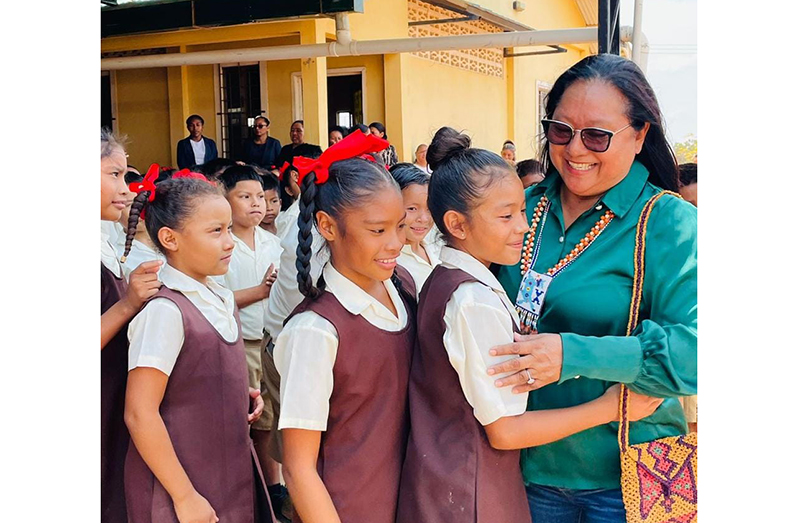EARLIER in the month, the Minister of Amerindian Affairs, Pauline Sukhai, commissioned a number of projects in the communities of Quiko and St. Ignatius, Region Nine (Upper Takutu-Upper Essequibo). The completion of a $9 million four-acre savannah farm has opened the door for Quiko, a small town in South Central Rupununi, to engage in large-scale cash crop cultivation.
Through the sale of carbon credits issued by Guyana under the Low Carbon Development Strategy (LCDS 2030), finance for the project was made available.
The villagers will be able to grow vegetables on the farm, including watermelon, bora, eschallot, and sweet peppers, among other kinds of crops, to provide the government’s hot meal programmes, which supplies the Rodeo Arena, a Youth Document Centre, a Women’s Sewing Centre, and a Catering Kitchen.
The Senior Councillor of Quiko, Ronald Ignatius, stated that the community developed the idea holistically, understanding the significance of food security, safety, and affordability.
He pointed out that while generating cash is a significant component, giving local residents job opportunities is an equally vital aspect of the initiative.
The senior councillor explained that “our main crop is cash crops, as you can see around. We have eschalot…those crops that are cash crops to supply hot meals, private entities that do catering, and so (on)… We are creating job opportunities by having this large farm. We decided to employ persons in the community that have children attending secondary schools in order to have an income at the end of the day (and) other young people to have knowledge of these farming techniques.”
Additionally, in the Amerindian village of St. Ignatius, Region Nine, projects valued at over $20 million were put into motion.
Among these are a farine factory to strengthen the local economy and create jobs, and an expanded hot meal kitchen to guarantee that elementary school students get the nourishment they require.

A second kitchen was also commissioned so that women in the hamlet could provide catering services.
During the commissioning of the project, Minister Sukhai said: “The village will now have a farine processing unit, which was built at a cost of $14 million. This will support the processing of cassava, which is a vital ingredient for many indigenous dishes. That will bring great ease to the women who oftentimes have to manually grate the cassava.”
Furthermore, Minister Sukhai said: “$5 million was also invested towards the extension of the St. Ignatius Primary hot meal building. This building has since been equipped with a freezer, a fridge, a kitchen cupboard, and a microwave, among other appliances.”
Another $1.8 million was used to fence the village office, and another $1.8 million was used to construct a kitchen for the community’s female residents. These projects’ creation extends far beyond community development; instead, they now support and are components of tourism amenities.
As a result, by giving visitors the food and lodging they require and by developing tourism-based activities and educational opportunities for them, the villagers will be able to use these projects to foster a welcoming atmosphere for visitors.
In addition, Minister Sukhai gave the Amerindian residents an overview of the budget for 2024 and related that there are many exciting things planned for the ongoing advancement of the Amerindian people and their communities.
She added, “In this year’s budget, $2.7 billion will be disbursed to Amerindian villages from the Carbon Credit Funds. And I want to say that the Carbon Credit Funds have become very useful not only to the villages but to the entire country.”
Finally, Minister Pauline Sukhai assured the St. Ignatius villagers that the government will keep providing funds and policies to assist the growth of developing Amerindian communities.
The minister said, “For the Ministry of Amerindian Affairs, we continue to be funded; we will be providing presidential grants, we will be providing support under the capital projects – for projects that we would have received from the leadership of your communities across the length and breadth of this country. The prioritisation of those will take place, and then we will be able to proportionately support projects in various villages.”
Hess Corporation, and the Government of Guyana inked a multi-year deal for US $750 million in 2023 that calls for the company to buy $2.5 million in credits each year.
Over 242 Amerindians, hinterland, rural, and riverine communities and villages received US$22.5 million in payments after the first payment of US$150 million was received in 2023.
The mechanism agreed with the National Toshaos Council for allocating funds from Guyana’s carbon credit sales was informed by the population size with the payments to each village for year 2023 ranging between $10 million and $35 million.
(This is part of a weekly series on LCDS) The author can be contacted at cparkinson0206@gmail.com




.jpg)









